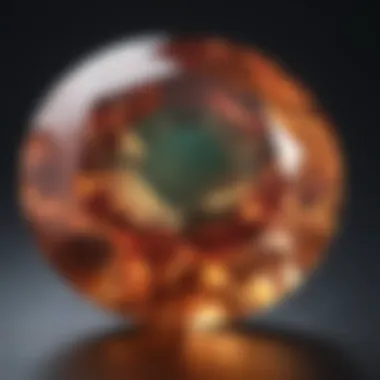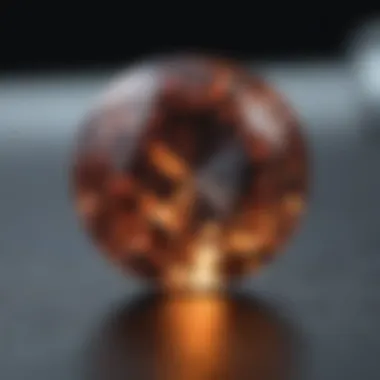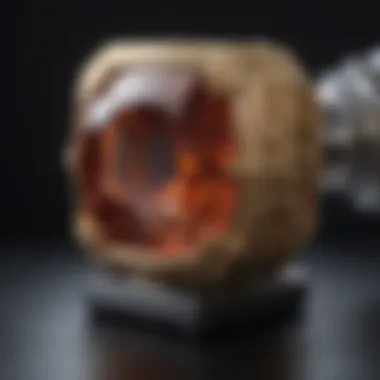Exploring MS Laser Technology for Gemstone Analysis


Intro
MS laser technology represents a noteworthy advancement in the realm of gemstone identification. It leverages the principles of laser spectroscopy, fostering enhanced accuracy in analyses. This article offers an in-depth exploration of how this technology is impacting gemological practices, allowing professionals and enthusiasts to better assess and verify gemstones.
Overview of Gemstones and Minerals
Gemstones, typically minerals or rocks utilized for their aesthetic appeal and rarity, have been cherished throughout human history. They have significant roles in cultural practices, adornments, and icons in various societies. Traditionally, gems symbolize wealth and prestige due to their rarity and richness in colors.
History of Gemstone and Mineral Use
For thousands of years, civilizations have revered gemstones. Ancient Egyptians considered lapis lazuli sacred, while Romans adorned themselves with sapphires. Different cultures attribute various meanings and values to stones, making them pivotal in religion, rituals, and royal ornamentation.
Significance in Culture and Society
Gemstones serve as tokens of love, luck, and protection, contributing to personal and communal stories. Rings adorned with diamonds often signify engagement, while birthstones are cherished during birthdays. The emotional and cultural significances engraved in these gems transcend their physical attributes, underscoring their importance.
Gemstone Formation and Properties
Each gemstone emerges through unique geological processes that shape its eventual appearance and characteristics. Understanding these properties is crucial for effective identification.
Formation Process of Gemstones
Many gemstones crystallize from magma or form through metamorphic processes. High pressure and temperature facilitate mineral changes, resulting in stunning gemstones within the Earth's crust. This journey contributes to their diverse appearances and physical attributes.
Properties that Define Gemstones
Key properties that characterize gemstones include their hardness, clarity, and color. Hardness, measured on the Mohs scale, indicates resistance to scratching. Clarity reflects internal flaws or inclusions, and color can vary widely, significantly influencing a stone’s desirability and value.
Classification based on Color, Hardness, and Luster
- Colors and distributions help classify various gemstones.
- Hardness defines their durability.
- Luster helps recognize quality, determining if light refracts or reflects from their surfaces. Understanding these properties greatly assists with gem valuation.
Types of Gemstones
The gems come in different classifications, from the more familiar precious stones to the relatively underrated varieties.
Precious vs.
Semi-Precious Gemstones
Traditionally, diamonds, rubies, sapphires, and emeralds are termed precious due to their rarity and demand. Other stones, like garnet and amethyst, are categorized as semi-precious and are often available in higher quantities. Though their pricing varies, both types have significant value to collectors.
Common Gemstone Varieties
Some widely recognized gemstones include:
- Diamonds
- Rubies
- Sapphires
- Pearls
- Opals These have unique properties that intrigue gem collectors and enthusiasts.
Exotic and Rare Gemstones
Among exotic stones, tanzanite and alexandrite capture attention due the ingenious transformations during cutting. Their fascinating quality is driven by rarity and unique optical properties.
Identifying and Evaluating Gemstones
Effective identification is key to valuation in the gemstone market. Various methods assist professionals with this task.
Factors Affecting Gemstone Value
Gemstone value is affected by aspects such as:
- Size and weight
- Cut and clean characteristics
- Color intensity and consistency
- Provenance Each contributes uniquely to market fluctuations and value insights.
Techniques for Gemstone Identification
M Spectroscopy is among the leading mechanisms to ascertain gemstone authenticity. The MS laser technology leverages precise spectra generated from gemstones, simplifying assessment details greatly. Identification practices have evolved with the technology introduction, thus ensuring higher accuracy.
Assessing Gemstone Quality


Assessment hinges on the combination of the aforementioned factors, lending much gravitas to the appraisement landscape and prohibiting mishaps when defining value.
Caring for Gemstones
Proper care and storage play a crucial role in ensuring long-lasting beauty for gemstones.
Cleaning and Storing Gemstones Properly
Routine maintenance, using mild soap with nwarm water could enhance a stone's appearance, extending its Item lifespan. Storage in soft, breathab containers helps prevent scratches.
Avoiding Common Mistakes in Gemstone Care
It is paramount to avoid exposure to hard chemicals and harsh cleaning tools. They may both compromise the stone. Normal cleaning methods should be prioritized, ensuring longevity.
Preservation Tips for Specific Gem Types
Each gemstone type requires understanding. For example, pearls should eschew harsh solutions, while diamonds brim from rigorous cleanings.
Preface to MS Laser Technology
MS Laser Technology plays a pivotal role in enhancing gemological practices. With the ability to deliver precise and reliable results, this technology reshapes how gemstones are identified and analyzed. This section will lay the foundation for understanding the implications of integrating MS laser technology in gemology. It emphasizes the importance of accuracy and non-invasiveness in a domain where authenticity is key for both value and customer trust.
Definition and Basics of MS Laser
The term MS Laser refers to multiple systems of laser spectroscopy employed for various applications in the identification of gemstones. It essentially involves using high-intensity beams of light that break down the molecular structure of different materials. In gemology, this allows experts to distinguish between natural stones and synthetics with unparalleled accuracy. Various wavelengths generate specific patterns, which are closely examined to ascertain the type, quality, and origin of gemstones. As a result, MS lasers significantly aid gemologists in making informed decisions, ensuring that customers receive genuine and verified products.
Historical Context of Laser Development
The development of laser technology marks a significant milestone in scientific history, emerging from theories around electromagnetic radiation behavior. The concept of the laser was developed in the 1960s with the invention of the first operational laser by Theodore Maiman. Over decades, advancements in laser technology have evolved rapidly. By the late 1990s, researchers began applying lasers in different fields, including gemology. The incorporation of laser techniques in the identification of gemstones provided a new dimension to the field, enabling rapid and reliable analysis. This historical perspective emphasizes how continuous development and innovation result in more sophisticated tools for gemologists and increase the overall trust within the gemstone market.
Principles of Laser Spectroscopy
Laser spectroscopy plays a critical role in gemstone analysis, leveraging the unique properties of light-matter interactions. This technology provides precise and detailed results that traditional methods often overlook. By using lasers to excite the electrons of gem materials, experts can obtain a spectrum that reveals crucial insights about the stone's composition. These insights prove invaluable for gem identification and authenticity verification.
How Laser Spectroscopy Works
Laser spectroscopy operates on fundamental principles of physics and optics. When a laser beam is directed at a gemstone, the energy from the laser interacts with the atoms or molecules in the stone. As a result, these atoms absorb specific wavelengths of light. The absorbed wavelengths correspond to the particle’s electron energy levels. Upon absorbing energy, the electrons elevate to a higher energy state and, when they relax, emit light at distinct frequencies.
The emitted light is then analyzed using various instruments like spectrometers, resulting in a spectrum unique to each gem type. Some gems, such as diamonds, emit very specific wavelength patterns that can be used for accurate identification. This not only allows for straightforward gemstone analysis but also aids in differentiating natural stones from synthetic or treated counterparts.
Different types of spectroscopy techniques may include micro-Raman spectroscopy and laser-induced breakdown spectroscopy (LIBS). Each has unique merits, suitable for specific gemological applications, making laser spectroscopy a versatile tool in the gem identification domain.
Types of Laser Techniques Used
The application of laser techniques in gem analysis is both varied and vital. Here are some prominent types used in the industry:
- Micro-Raman Spectroscopy: This method utilizes near-infrared laser light, providing detailed information about a gemstone's molecular structure. Micro-Raman is excellent for detecting subtle differences in gem treatment statuses that other techniques may miss.
- Laser-Induced Breakdown Spectroscopy (LIBS): LIBS focuses high-energy laser pulses onto the surface of the gemstone, causing localized vaporization. This creates a plasma, which emits light detailing the elemental composition of the material. This method enables real-time analysis of the stone in question.
- Fourier Transform Infrared Spectroscopy (FTIR): While not exclusively a laser technique, FTIR analyzes the infrared light wavelengths absorbed by gem materials indicating the presence of various functional groups and contaminants.
Understanding these techniques helps professionals in the field to select the most appropriate method for their specific needs, ensuring effective and reliable gemstone evaluation. Each type posses its advantages, promising enhanced accuracy and reliability over traditional methods.
Recognizing the right technique is crucial; it significantly influences both the quality of the results and the decisions made based on those findings.
These various laser techniques signify an evolving era of gem analysis. Enhanced performance and versatile application scope of these methods assure professionals within the gemstone industry of reliable identification and assessment processes.
Applications of MS Laser in Gemology
Applications of MS laser technology in gemology are significant. They enhance the methods used in the identification, assessment of authenticity, and analysis of gemstone treatments. Through these applications, gemologists gain better tools for ensuring the quality and value of gemstones. Here, we will explore these specific areas to understand the importance and benefits in contemporary gemological practices.
Gemstone Identification
Gemstone identification is a crucial component in the field of gemology. The use of MS laser technology in this realm arms professionals with a reliable means to determine the nature and origin of gemstones. However, traditional methods of identification could sometimes yield misleading results due to the Solidity of Common Gemstones.
MS laser technology allows for more precise assessment. For example, applying through Laser Induced Breakdown Spectroscopy, gemologists can analyze minute chemical compositions with a high degree of accuracy. This method offers several benefits:
- High-resolution results provide clear data on elemental composition.
- Instantaneous readings give up-to-date information on gemstones.
- Access to previously hard-to-define features in stones could change certain perceptions in the market.
A clear case pointing to its importance is in distinguishing between natural and synthetic stones. The demand for natural gemstones has soared, raising the need for credible identification techniques.


The integration of MS laser analysis delivers objective data confirmed through scientific methods, thus aiding gemologists in making informed decisions.
Assessment of Gemstone Authenticity
The assessment of gemstone authenticity has modernized essential procedures for verifying the genuineness of gemstones. Counterfeit gemstones and imitations pose a risk in today's market. Hence, adopting MS laser technology is indispensable in combating this issue effectively. Traditional methods may seem insufficient against expert counterfeiters.
One relevant advantage of laser technology is its ability to perform multifaceted analyses on the rarity of stones. For example, it can help identify unique characteristics of natural gemstones that are traces of their origins. Key points regarding the assessment of authenticity include:
- MS laser technology facilitates an in-depth examination of gemstone cores.
- Multiple parameters can be evaluated simultaneously, simplifying the verification process.
- It can also identify treatments applied to gemstones that could affect their market value.
Ultimately, various industry stakeholders are afforded longer-term protection from fraudulent activities through consistent laser-based assessments.
Analyzing Gemstone Treatment Processes
Analyzing gemstone treatment processes is another critical application of MS laser technology. Many gemstones undergo treatments to enhance their appearance. Understanding these treatments becomes essential in establishing genuine market practices. MS laser technology provides detailed insights into how these treatments alter gemstone properties, such as color or clarity.
The benefits here are numerous. Not only does it provide factual alterations made to a gemstone, but it also educates buyers on the real nature of their purchases. Enhanced understanding around:
- Different types of treatments means that buyers can make informed decisions without blind trust in sellers.
- Detection of alterations helps maintain transparency within the market and solidify confidence among consumers.
In summary, MS laser technology is revolutionizing the approach gemologists take toward examining precious stones. The applications in gem identification, authenticity determination, and treatment analysis all represent a significant leap forward. These advancements have positively impacted how professionals and customers engage with gemstones, thus aligning practices with modern technological efficiencies.
Benefits of MS Laser Technology
The adoption of MS laser technology has led to significant advancements in gemstone identification and analysis. For gemologists and professionals in the jewelery industry, understanding these benefits can directly influence their work quality and efficiency. This section breaks down the key advantages that MS laser technology provides.
Increased Accuracy and Precision
One of the most significant benefits of MS laser technology is its ability to deliver high levels of accuracy and precision. Traditional methods of gemstone testing often involve time-consuming processes that can lead to human error. MS lasers, on the other hand, use light-based techniques that significantly reduce these chances. The laser interacts with the stone at a molecular level, gathering detailed information about its composition. As a result, gemologists are able to attain more accurate readings, which enhances overall trust in their assessments.
Key points regarding accuracy and precision include:
- Minimized subjectivity: Reliance on machines helps eliminate personal biases in analysis.
- Detailed data output: Spectroscopic readings provide exact details on elemental composition, eliminating uncertainty.
- Enhanced repeatability: These readings can be reliably reproduced at different times and under various conditions.
“The hallmark of advanced gemological methods lies in their integrity; accurate information propels the industry forward.” - Expert gemologist
Non-Destructive Testing Capabilities
The ability to conduct non-destructive testing is another compelling benefit of MS laser technology. This method allows gemologists to assess the quality and authenticity of gemstones without causing any harm. Being able to analyze gems without risking damage is invaluable, especially for high-value pieces. When professionals understand the full history and treatment of a gemstone, they can better serve their clients and protect investments.
Highlighting how non-destructive testing benefits various aspects of gem analysis includes:
- Preserving integrity: Gemstones maintain their original condition while being assessed.
- Real-time analysis: Immediate readings can be taken without a lengthy evaluation process.
- Wider collaboration possibilities: Improved methods allow for shared assessments among professionals using the same technology.
Rapid Results and Analysis
Speed is critical in the jewelry industry, where timely assessments can impact purchasing decisions. MS laser technology offers rapid results that keep pace with an increasingly fast-moving market. By producing real-time data, gemologists can immediately provide insights, thereby speeding up the entire gem identification process. This efficiency enacts a favorable cycle, enabling quicker transactions and a more knowledgeable customer base.
Factors contributing to rapid results include:
- Instant feedback: Provides immediate data analysis as soon as testing concludes.
- Efficient workflow integration: Fits seamlessly within established processes, allowing for smooth transitions.
- Reduced labor-intensive procedures: Less reliance on time-consuming manual checks results in faster turnover.
Limitations of MS Laser Technology
MS laser technology offers significant advantages in gemstone identification, yet it is not without its limitations. Understanding these constraints is crucial for both gemologists and industry stakeholders. Recognizing the areas where laser technology might fall short allows for better integration into gemological practices and more informed decision-making when choosing methods for gemstone analysis.
Technical Limitations in Certain Gem Types
While MS laser spectroscopy is versatile, it is not infallible. Certain gemstones present unique challenges due to their physical and optical properties. For instance, gems like opal, with their structural water and internal light diffraction, may respond poorly to laser tests.
Characteristics that can hinder accurate readings include:
- Fluorescence: Some gemstones can fluoresce under low-energy lasers, leading to misleading results.
- Heat Sensitivity: Certain materials may degrade or change color when exposed to laser light, complicating assessment.
- Internal Inclusions: Gems with many internal flaws can scatter laser beams unpredictably, confusing data readings.
When evaluating the suitability of laser technology for specific gems, professionals must weigh methods against these technical barriers.
Cost Implications for Small Businesses


Although MS laser technology can greatly enhance gemological assessments, the implementation and maintenance costs can be significant. This becomes a substantial concern for small businesses, which may have limited budgets. Equipment such as the Bruker 80e or Horiba Scientific un LASER III can involve substantial upfront investments.
Considerations include:
- Equipment Purchase or Leasing: The high cost of acquiring laser spectrometers. Small jewelers often opt to lease equipment or collaborate with labs for testing.
- Training Costs: The personnel need training to operate sophisticated laser equipment effectively. This may require investment in specialized courses or resources, which can strain financial resources.
- Maintenance Expenses: Lasers often require regular maintenance, which can lead to ongoing costs that accumulate over time.
Considering these elements can offer small businesses insights into whether the advantages of utilizing MS laser technology outweigh the financial hurdles.
"Understanding limitations is essential to maximizing the effectiveness of MS laser technology in gemology."
Integration with Existing Gemological Practices
Integrating MS Laser technology into existing gemological practices is vital for several reasons. First, it allows established gemologists to enhance their identification processes. It provides a level of accuracy that traditional methods can't replicate. By incorporating lasers, gem professionals can offer more reliable assessments, which is particularly important for collectors and retailers who depend on authentic findings.
Moreover, MS Laser technology complements existing methodologies instead of replacing them. This synergy can lead to improved assessments of gemstone authenticity and valuation. For example, visual inspection and traditional testing methods can work alongside laser spectroscopy, providing a more comprehensive evaluation of gemstones.
Another significant factor is the adaptability of current gemological equipment. MS Laser devices can often be integrated without extensive modifications to existing processes. Training staff to adapt to these technological enhancements is manageable, thus paving the way for broader applications in gemology, without a steep learning curve.
Combining MS Laser with Traditional Methods
The combination of MS Laser technology with traditional approaches in gemology creates a multi-faceted strategy for identifying gemstones. Gemologists can utilize visual examinations and historical context as a primer before turning to laser analysis for deeper insights. Here are some ways in which this integration is beneficial:
- Enhanced Verification: Laser technology provides data that confirms or refutes findings from traditional methods.
- Accumulated Knowledge: Experienced professionals can effectively transfer their skills and insights into a laser-based context.
- Increased Efficiency: Laser methods can expedite the analysis, while traditional methods can still assure thorough examination.
Combining the strengths of both methods ensures a balanced approach to gem identification and validation. This holistic view improves the overall reliability of the outcomes.
Training Professionals for Laser Implementation
Training professionals on how to effectively integrate MS Laser technology is critical for successful deployment in any gemological facility. Effective training involves several key areas:
- Comprehensive Understanding: Employees should learn basic laser principles, along with operational concerns of the equipment.
- Hands-On Practice: Real-world applications and practice are vital, so that professionals become confident using the lasers in their workflow.
- Evaluation Techniques: Training should encompass understanding and interpreting the spectroscopic data yielded by lasers. This knowledge will empower gemologists to make informed decisions based on accurate readings.
Furthermore, offering continuous education on the advancements in laser technology will keep gemologists updated and proficient. Updated training protocols will not only maintain competence but also instill a sense of confidence, surfacing greater possibilities in the gemology field.
A well-trained gemologist adept in using MS Laser technology can not only verify but also introduce new ways in gemstone analysis that enhance credibility throughout the jewelry industry.
Integrating technology effectively leads to smarter evaluations, ensuring that gem professionals adapt while keeping the essence and nuances of traditional methods. It is a collaborative way forward into the future of gemology.
Future Prospects of MS Laser in Gemology
The future prospects of MS Laser technology in gemology are compelling and hold promise for significant advancements in gem identification and analysis. Focusing on key areas within the field will clarify how MS Laser fits into emerging trends and how it can help meet the growing demand for precision in gemological assessments. The continued development of laser technology allows for innovations that could further improve the accuracy and efficiency of gemstone evaluations.
Advancements in Laser Technology
The landscape of laser technology is constantly evolving. Investment in research and development is crucial for breakthroughs that push the boundaries of current capabilities. Some promising advancements being pursued today include:
- Higher Resolution Imaging: Improved resolution will enhance the ability to detect minute details in gemstones, revealing structural and compositional factors that were previously elusive.
- Enhanced Light Sources: Utilizing a wider range of wavelengths can facilitate deeper penetration and clearer signals from a wider variety of gemstones. As a result, experts could see detailed internal structures more readily.
- Portable Laser Systems: Development of compact and portable laser systems mean that gem analysis can be performed in the field, making it accessible in remote locations.
The implications of these advancements are vast. Increased capabilities would undoubtedly command a stronger presence in gemological practices around the globe.
Potential for Broader Industry Adoption
The shifting dynamics of the gemstone market indicate that the integration of MS Laser technology will likely become more widespread across the industry. Factors contributing to this growing acceptance include:
- Increased Demand for Authenticity: Consumers today exhibit a deeper interest in knowing the provenance and quality of gemstones. MS Laser technology offers steps toward transparent and reliable testing, catering to such demands.
- Educational Programs and Training Opportunities: As laser technology becomes more prevalent, institutions and organizations can offer education resources and training for gemologists. Familiarity with MS Laser technologies will become a standard skill set, thus enhancing professional standards.
- Cost Efficiency in Long-Term Use: Though initial investments may be substantial, the increased efficiencies in testing and the enhancement of service offerings ultimately pay off for businesses. With precise authenticating capabilities, customer confidence rises, further promoting loyalty.
Integration of MS Laser technology in gemology may transform the landscape swiftly rather than gradually.
As we consider the broader implications, the potential adoption of MS Laser technology by various stakeholders from manufacturers to retailers highlights its value concerning market shifts and trends. As technological improvements taking place and functionalities expand, the entirety of the gem industry can shine a little brighter.
End
Summary of Key Insights
The prior sections illustrate several crucial points regarding the implementation of MS laser technology:
- Enhanced Accuracy: The precision offered by MS laser makes it a unique tool for accurately identifying gemstone characteristics.
- Non-Destructive Testing: This aspect allows gemologists to analyze stones without causing any damage, preserving their integrity.
- Rapid Results: Time efficiency is essential in professional scenarios, and MS laser technology provides quick yet reliable analyses.
- Integration with Traditional Methods: While modern technology is beneficial, the combination with existing practices brings the best of both worlds.
- Forward-looking Applications: As the technology progresses, future prospects seem promising with broader applications likely beyond current uses.
Final Thoughts on MS Laser Implementations
The implementation of MS laser technology extends far beyond just identification; it shapes the future of the gem industry. By embracing this advanced technology, professionals can address challenges currently faced in gemology. Investing in its integration not only meets modern standards but also anticipates future advancements.
Consequently, the adoption of MS laser technology encourages researchers and jewelers alike to push the boundaries of their craft. A commitment to understanding and applying these methods will ultimately lead to heightened appreciation and a deeper understanding of gemstones.







